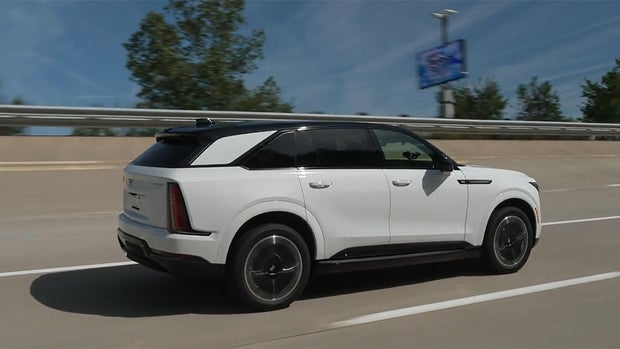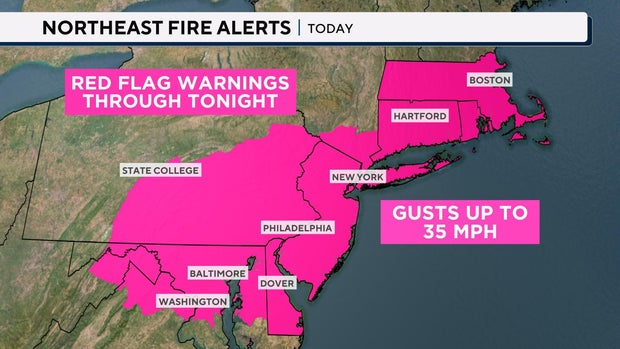CBS News
GM’s CEO on electric vehicles: “This is one of the most exciting times in our industry”

During her ten years as CEO of General Motors, Mary Barra has made big investments in software and driverless cars. At a 2021 trade show, Barra said, “At General Motors our vision for the future is a world with zero crashes, zero emissions, and zero congestion. The key to unlock that vision is electrification.”
But it was her promise three years ago to stop selling gas-powered vehicles by 2035 – and GM’s ability to live up to it – that will likely define her legacy.
Asked if she anticipates GM will be all-electric by 2035, Barra replied, “For our light-duty vehicles, yes. We’ll be guided by the consumer, but the plans that we have in place will get us there.” Nonetheless, in the face of slowing EV sales, Barra said, “I don’t think we ever thought it was gonna be linear.”
CBS News
Wall Street darling Tesla still dominates the market with nearly half of the EVs on the road in the United States. But their market share is shrinking. And with nine all-electric cars and trucks currently available, and four more on the way, GM seems determined to catch up.
“Sunday Morning” was the first to drive GM’s highly-anticipated and soon-to-be-released electric Cadillac Escalade IQ. Starting around $130,000, with a range of at least 460 miles per charge, it includes features like the semi-autonomous Super Cruise, which allows hands-free driving on many roads.
CBS News
For a peak at what else is around the corner, GM invited us for a rare look inside its century-old Milford Proving Ground. A 45-minute drive from the company’s headquarters in Detroit, the Proving Ground has long been a hub for automotive innovation. GM conducted the industry’s first rollover test, and the first crash test using those famous dummies, all right here.
Today, the 4,000-acre site is home to more than 140 miles of every kind of test track imaginable, from off-road to brick road, even an honest-to-goodness race track.
Tony Roma, the executive chief engineer for Corvette, took us for a spin in the new ZR1. With 1,064 hp and a top speed over 200 mph, it’s the fastest Corvette ever. On this day we managed to hit 170.
CBS News
Van Cleave asked, “With all of the computer modeling you guys do now, why is any of this necessary?”
“You still need to stress the components to correlate the models,” Roma replied.
Every detail of the ZR1 is being perfected at Milford, from the handling to that signature Corvette sound. “We put a lot of effort into the sound – the startup sound, the sound when it’s accelerating,” Roma said. “We’ll do 50 or 60 different iterations. It’s like tuning an instrument.”
“On some level, does a Corvette always need to be a gas-powered vehicle?” asked Van Cleave. “Can you have that sound and that feel [with a hybrid]?”
Roma replied, “We talk about this a lot. I talk about this with enthusiasts, my friends, other engineers.”
Last year, GM’s introduction of its hybrid Corvette, the E-Ray, was met with some initial skepticism. But that has not dampened speculation that an all-electric Corvette isn’t far behind, fueled in part by President Biden, who said in 2021, “I have a commitment from Mary. When they make the first electric Corvette, I get to drive it!”
CBS News
According to Roma, “We’re not going to apply electrification just for the sake of it. We don’t put technology on just for technology’s sake. It kind of has to earn its way in, has to make the car better in some way that our customers are going to respond to.”
Most Americans have so far been reluctant to make the switch and plug in. Last year, electric vehicles made up only about eight percent of new car sales; and government subsidies aimed at speeding the transition have become a contentious issue on the campaign trail.
Barra was surprised that EVs have become a political issue: “I never thought the propulsion system on a vehicle would be,” she said. “Again, I think one of the strengths of General Motors is we’re giving people choice. We’re not telling you what you have to have. We’re saying, if you want this, we have it.”
Adoption of EVs is happening fast in other countries, and most analysts believe it will eventually catch up here, leaving Detroit in a lurch if they aren’t ready to compete.
Barra believes the legacy car makers can move fast enough: “I absolutely believe yes, we can, and I think yes, we are,” she said. “Our workforce is quite young. Most of our technical talent has been with the company less than five years – I would say about 40 percent. They’re joining because they want to be part of the company that is going to change and lead in the move to electric vehicles.”
“So, too soon to ask you about your legacy?” asked Van Cleave.
“I think legacy is what someone else writes,” she said. “I hope everybody knows, I love this company, I believe in the team.”
Barra is GM’s second-longest-serving CEO, but she’s showing no sign of slowing down. And for good reason: the future of this iconic American company is riding on whether or not she’s right about the road ahead.
“I think this is one of the most exciting times in our industry,” Barra said. “There’s so much change right now that – for an engineer – it just makes it super-exciting.”
For more info:
Story produced by Mark Hudspeth and Kathryn Krupnik. Editor: Remington Korper.
CBS News
Iranian operative charged in pre-election scheme to assassinate Trump, other U.S. targets

An operative working for Iran’s Islamic Revolutionary Guard Corps told federal investigators that he was tasked in September with “surveilling, and, ultimately, assassinating” President-elect Donald Trump, according to court records unsealed Friday.
Prosecutors say Farhad Shakeri, who is believed to be residing in Iran, told investigators in a phone interview that unnamed IRGC officials pushed him to plan an attack against Mr. Trump last month. If the plan could not come together in time, the Iranian officials directed Shakeri to delay the plot until after the presidential election because the official “assessed that [Mr. Trump] would lose the election,” charging documents revealed.
Shakeri and two individuals living in the U.S. — Carlisle Rivera of Brooklyn, New York; and Jonathon Loadholt of Staten Island — were charged as part of a broad Iran-backed scheme to allegedly surveille and ultimately assassinate individuals inside the U.S. who opposed the Iranian regime.
FBI investigators wrote that Shakeri immigrated to the U.S. as a child from Iran, but was deported in 2008 after serving more than a decade in prison on robbery charges. They alleged the IRGC ultimately used Shakeri to recruit criminal contacts inside the U.S. to carry out specific operations like targeting an unnamed Iranian American journalist and activist living in New York.
In February, prosecutors alleged Shakeri paid Rivera and Loadholt about $1,000 to monitor the activist — who has spoken out against Iran’s regime — at an event at Fairfield University in Connecticut. The surveillance operations continued into March, according to court documents, when the pair allegedly traveled multiple times to the activist’s Brooklyn home. Text messages, security camera footage and cell site location data revealed their numerous trips.
“On or about April 1, 2024, 9 SHAKERI and RIVERA exchanged voice notes discussing RIVERA and LOADHOLT’ s efforts to locate and murder” the Iranian American, court records said.
“This b**** is hard to catch, bro,” Rivera allegedly said to Shakeri. “There ain’t gonna be no simple pull up, unless there[‘s] the luck of the draw.”
According to court records, Shakeri allegedly responded later, “you just gotta have patience and don’t, kicking, kick in the door is not an option because that’s a fail, that’s a fail maneuver. You gotta wait and have patience to catch her either going in the house or coming out, or following her out somewhere and taking care of it. Don’t think about going in. In is a suicide move.”
Investigators searched online accounts belonging to Rivera and Loadholt in the course of the federal probe and uncovered numerous images of firearms and other weapons.
In April, Shakeri agreed to pay Rivera and Loadholt $100,000 to “finish the work” and said he was tasked by the IRGC to hire individuals to assassinate the journalist. And by July, according to charging documents, the Iranians were growing impatient, instructing their U.S. assets to “take care of it already.”
The alleged plot to kill the activist did not succeed.
Rivera and Loadholt are not accused of being part of the plot to target Mr. Trump. They made their initial appearance in federal court on Thursday and were ordered detained, according to the Justice Department. Shakeri remains at large.
“We will not stand for the Iranian regime’s attempts to endanger the American people and America’s national security,” Attorney General Merrick Garland said in a statement.
The charges announced Friday are not the first brought against alleged operatives of the IRGC for plotting to kill Mr. Trump. Earlier this year, the FBI arrested Asif Merchant for planning to assassinate U.S. government officials, including potentially the president-elect. Merchant remains in custody and pleaded not guilty.
On at least five occasions between September and November, Shakeri participated in “voluntary telephonic interviews with FBI agents” in exchange for a sentence reduction for another individual serving time in the U.S, court records said.
During the interviews, he allegedly told the FBI of the IRGC’s desire to kill the Iranian American activist and target Israeli tourists in Sri Lanka with a mass shooting event. Shakeri also told investigators that the IRGC tasked him with surveilling two Jewish American citizens living in New York, but he did not provide the Iranian officials with information about the unnamed targets.
During the interview, Shakeri also allegedly told the FBI about the effort to target Mr. Trump.
In a statement, FBI Director Christopher Wray said, “The Islamic Revolutionary Guard Corps — a designated foreign terrorist organization — has been conspiring with criminals and hitmen to target and gun down Americans on U.S. soil and that simply won’t be tolerated.”
The charges and allegations announced Friday are part of broader posture by U.S. intelligence and law enforcement to publicly bring attention to Iran’s alleged efforts to quiet dissidents on U.S. soil and target U.S. government figures after the killing of IRGC General Qasem Soleimani by American forces in 2020. Mr. Trump and former members of his administration have been forced in recent years to increase his security due to the threats.
The Justice Department has charged numerous other defendants in recent years with acting on behalf of Iran by targeting outspoken dissidents living in the U.S.
Attorneys for Rivera and Loadholt were not immediately identified.
CBS News
Maps show drought and fire conditions in Northeast states

The Northeastern U.S. is experiencing ongoing drought conditions, which is helping to fuel an uptick in fire danger. For Friday, an elevated fire weather outlook was issued by the National Weather Service’s Storm Prediction Center for the area stretching from Massachusetts to the northern edge of Virginia and West Virginia.
CBS News
The threat with this elevated fire risk is due to winds picking up to 10-15 mph, with wind gusts upwards of 25-35 mph. Relative humidity levels are as low as 20% in some spots, as well. Red flag warnings have been issued into the evening hours of Friday across parts of the Northeast and New England.
CBS News
The weekly drought monitor came in on Thursday, and 57% of the Tri-State area of metro New York, New Jersey and Connecticut is under a moderate drought. Brushfires flared up along the New Jersey Palisades overnight while firefighters fought other blazes in southern New Jersey, and multiple wildfires have been burning in Massachusetts, where drought conditions range from moderate to severe.
CBS News
Here’s more on the conditions states in the region are facing:
For Massachusetts, 84% of the state is in MODERATE drought while 32% is in SEVERE drought. Boston received its last measurable rainfall on Oct. 30 of 0.18 inches. Boston’s average annual rainfall accumulation is 36.46 inches and the city has received 36.38 so far this year.
For Connecticut, 100% of the state is now in MODERATE drought, up from only 14% of the state at that level just last week. New Haven saw its last measurable rainfall back on Oct. 7 of 0.27 inches. (Technically it received 0.01 inches on Nov. 1 but that was not very significant.) Hartford, which receives an average of 40.25 inches of rainfall annually, has gotten 39.29 so far this year.
For New York, 85% of the state is ABNORMALLY DRY while 26% of the state is now in a MODERATE drought. New York City’s Central Park received its last measurable rainfall back on Sept. 29, with 0.78 inches. (Technically it got 0.01 inches on Oct. 29 but that was not significant either.) Central Park normally averages 42.38 inches of annual rainfall and has received 38.49 inches so far this year.
For New Jersey, 76% of the state is now under a SEVERE drought and it has worsened into an EXTREME drought in almost 20% of the southeastern section of the state. Newark Liberty International Airport had its last measurable rainfall on Sept. 29 of 0.39 inches. Newark receives on average 39.88 inches of rain annually and has received 34.82 so far this year.
For Pennsylvania, 22% of the state is now under a SEVERE drought with 4% in EXTREME drought. Philadelphia had its last measurable rainfall back on Sept. 29 of 0.11 inches. Philadelphia receives on average annual rainfall of 37.89 inches and has received 33.43 so far this year.
For Maryland, 53% of the state is now under a SEVERE drought with 4% in EXTREME drought. Baltimore saw its last measurable rainfall back on Oct. 1, with 0.35 inches. Baltimore averages 38.94 inches of rainfall annually and has only received 31.71 inches so far this year.
The dry conditions are not expected to last much longer in the Northeast, as the next chance of rain can come as early as Sunday night.
CBS News
When can a credit card company sue you for non-payment?

Getty Images
Credit cards can be a convenient way to manage expenses, but they also come with a serious responsibility to repay the borrowed funds on time. When a credit card account goes unpaid, it can result in late fees, penalty interest rates and damaged credit scores — and in certain cases, non-payment can lead to even more severe repercussions, like being sued for your unpaid debt. A lawsuit over unpaid credit card debt may sound extreme, but it’s a real possibility if your debts are left unaddressed.
The good news is that creditors don’t initiate lawsuits lightly — they typically attempt to work with the borrower first. But when these attempts fail and a credit card account remains delinquent, a lawsuit can be an option for creditors to pursue. Knowing when this step is likely to happen can help you take proactive measures to avoid such a scenario.
So when exactly can a credit card company sue you for non-payment? And what are the ways to resolve credit card debt without facing a lawsuit? Below, we’ll explain what you should know about when a credit card company can take legal action over unpaid debt and what strategies you can use to manage and reduce your debt load effectively.
Get rid of your delinquent credit card debt now.
When can a credit card company sue you for non-payment?
In general, a credit card company can sue you for non-payment once your account becomes severely delinquent, typically after 90 to 180 days of missed payments. When you initially miss a payment, the company will notify you and your account begins accruing late fees and possibly a higher penalty interest rate. As missed payments accumulate, the creditor’s collection efforts intensify. This can involve more frequent phone calls, letters and possibly offers to set up a payment plan.
If you’re unable to make a payment during this initial period, the account will likely be “charged off” or written off as a loss by the credit card company after 180 days of delinquency. At this stage, it’s common for the credit card company to sell the debt to a collection agency at a discounted rate — typically pennies on the dollar. At that point, the collection agency typically owns your debt.
Once a collection agency takes over your account, they have the right to pursue the debt on their own behalf. Collection agencies may contact you through calls, letters or other forms of communication to collect the balance. However, if the debt remains unpaid even after collection efforts, the collection agency may file a lawsuit. The decision to sue depends on several factors, including the amount owed, the collection agency’s policies and whether they believe legal action will yield repayment.
Receiving a lawsuit summons is typically the final warning that your debt has reached a critical stage. If the court rules in favor of the credit card company or collection agency, they may be granted a judgment that allows for methods like wage garnishment or property liens to recover the owed amount. Remember, though, that each state has a statute of limitations on debt, which is typically between three and 10 years. After that point, the creditor may no longer sue, although they can still attempt to collect it through non-legal means.
Find out how to lower your credit card debts today.
How to avoid a lawsuit over unpaid credit card debt
If you’re struggling with credit card debt, there are strategies available to avoid a lawsuit, including:
Contact your credit card company
When financial hardship makes it difficult to meet payments, one option is to contact your credit card company, as they may have hardship programs or alternative payment plans that can help. These programs can reduce interest rates, waive late fees or extend payment deadlines temporarily and addressing the issue early can prevent the account from escalating to collections or legal action.
Use debt relief to tackle what you owe
The following debt relief strategies could also be worth considering to avoid a lawsuit over unpaid credit card debt:
- Debt management: With a debt management plan, a credit counseling agency negotiates with your creditors to create a single, affordable monthly payment, often with reduced interest rates and fees.
- Debt settlement: With debt settlement (also known as debt forgiveness), the goal is to negotiate a lump-sum payment that’s less than the total owed, reducing your debt obligation.
- Debt consolidation loans: A debt consolidation loan through a bank or traditional lender may also be an option. This type of loan combines multiple credit card balances into a single loan, ideally with a lower interest rate, making monthly payments more manageable.
- Debt consolidation programs: When you enroll in a debt consolidation program, you work with a debt relief company to secure a debt consolidation loan through a third-party lender, allowing you to make one monthly payment at a lower rate.
The bottom line
Facing a lawsuit over unpaid credit card debt can be intimidating, but understanding when legal action is likely to happen can help you take control of your financial situation before it reaches that point. Early intervention, such as contacting your creditor or pursuing debt relief, can prevent your debt from escalating and help you manage repayment in a way that suits your financial needs. After all, taking the time to address unpaid credit card debt now can relieve stress and safeguard your financial future.

















